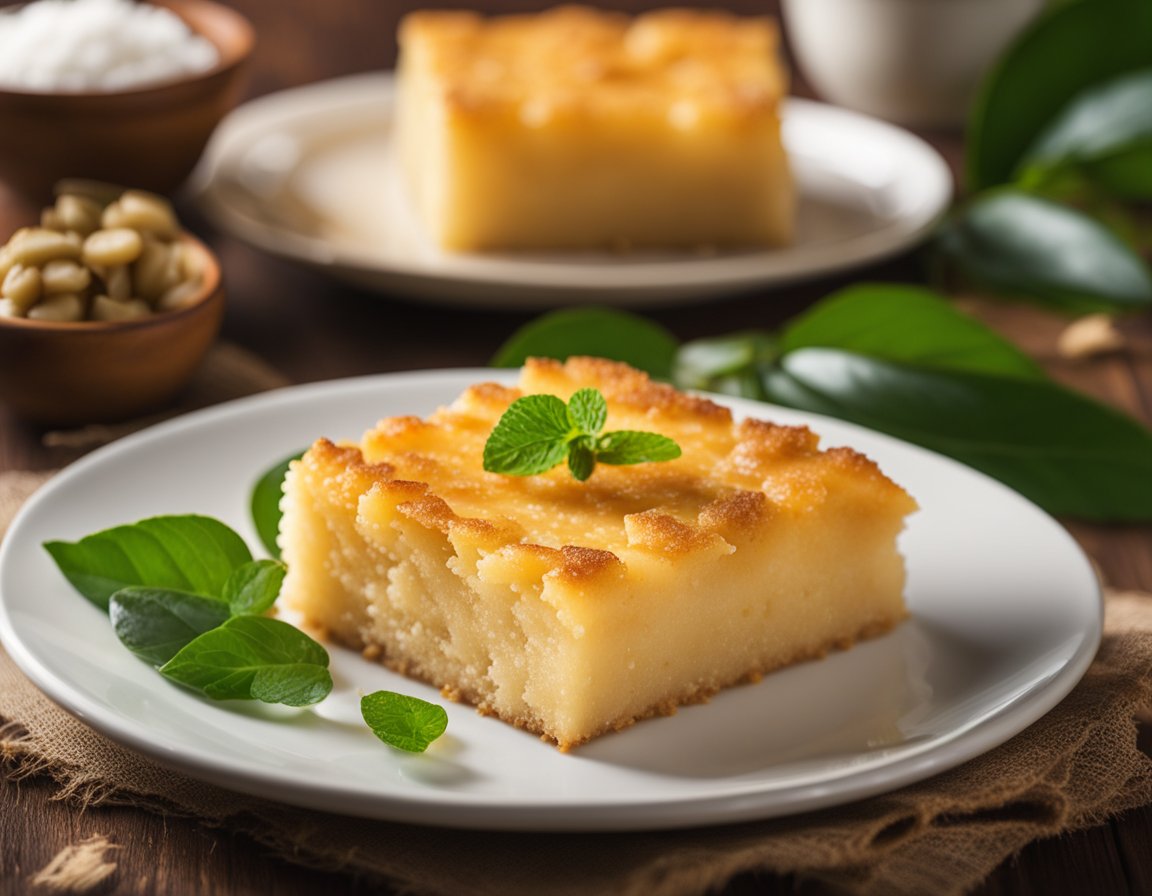As someone who loves to explore and try new foods, I recently discovered the deliciousness of Cassava Cake with Macapuno. This traditional Filipino dessert combines grated cassava, coconut milk, and sweet macapuno strings to create a unique and satisfying treat.
Cassava, also known as yuca, is a starchy root vegetable commonly found in tropical regions. When grated and mixed with coconut milk, sugar, and other ingredients, it becomes the base for this delectable cake. Macapuno, a sweetened coconut variety with a gelatinous texture, adds a delightful chewiness to the cake and complements the cassava’s natural flavor.
While cassava cake with macapuno is a popular dessert in the Philippines, it is still relatively unknown in other parts of the world. However, its unique taste and texture make it a dessert worth trying. Whether you’re a fan of coconut, cassava, or just looking for a new dessert to try, cassava cake with macapuno is a must-try.
History of Cassava Cake
Origin of Cassava
Cassava, also known as yuca or manioc, is a starchy root vegetable that is native to South America. It has been a staple food in many cultures for thousands of years. The cassava plant is easy to grow and can thrive in poor soil conditions, making it an important crop for many communities.
Evolution of Cassava Cake Recipes
Cassava cake is a traditional dessert that has evolved over time. It is believed to have originated in the Philippines, where it is known as “kakanin.” The earliest versions of cassava cake were made with grated cassava, coconut milk, and sugar, and were baked in clay pots over an open fire.
Over time, different variations of cassava cake emerged. Some recipes added eggs, milk, or cheese to the mixture, while others used different types of sweeteners, such as condensed milk or brown sugar. Some recipes also included toppings, such as macapuno, a sweet coconut preserve.
Today, cassava cake is enjoyed in many different countries and cultures, each with their own unique twist on the classic recipe. It has become a popular dessert for special occasions, such as weddings and holidays, and is often served alongside other traditional treats.
Ingredients for Cassava Cake with Macapuno
Cassava Root Essentials
To make a delicious Cassava Cake with Macapuno, I will need the following cassava root essentials:
- Grated Cassava Root
- Coconut Milk
- Evaporated Milk
- Condensed Milk
- Eggs
- Butter
- Sugar
- Baking Powder
- Vanilla Extract
Macapuno Strands
Apart from the cassava root essentials, I will also need Macapuno Strands. Macapuno strands are sweetened coconut meat that are often used as a topping for desserts. They add a unique texture and flavor to the Cassava Cake.
Additional Components
To give the Cassava Cake with Macapuno a little twist, I will also add some additional components such as:
- Shredded Cheddar Cheese
- Salt
- Coconut Cream
These ingredients will further enhance the flavor of the cake and make it more enjoyable to eat.
Preparation Steps
Peeling and Grating Cassava
To prepare cassava cake with macapuno, the first step is to peel and grate the cassava. I usually start by washing the cassava thoroughly and then peeling off the outer skin using a sharp knife. Once the cassava is peeled, I grate it using a box grater or a food processor. It is important to remove any fibrous parts or woody bits from the cassava to ensure a smooth texture in the cake.
Mixing Ingredients
After the cassava is grated, I mix it with the other ingredients. The main ingredients for cassava cake with macapuno include grated cassava, coconut milk, condensed milk, eggs, sugar, and macapuno strings. I mix these ingredients together in a large bowl until they are well combined. To enhance the flavor, I sometimes add a pinch of salt and vanilla extract.
Baking Process
Once the ingredients are mixed, I transfer the mixture into a greased baking dish. I preheat the oven to 350°F and then bake the cake for around 45 minutes to an hour. To check if the cake is done, I insert a toothpick in the center of the cake. If it comes out clean, the cake is ready. I let the cake cool down for a few minutes before slicing it into serving pieces.
Overall, preparing cassava cake with macapuno is a simple process that requires a few basic ingredients and some mixing and baking skills. By following these preparation steps, you can make a delicious and moist cake that is perfect for any occasion.
Serving Suggestions
Presentation
When it comes to serving cassava cake with macapuno, presentation is key. You can make it look more appetizing by slicing it into small pieces and arranging them on a platter. You can also add a few slices of fresh fruit, such as mango or pineapple, to add color and freshness to the plate. Another option is to sprinkle some powdered sugar on top of the cake, which can give it an elegant look.
Accompaniments
Cassava cake with macapuno is delicious on its own, but it can be even better when paired with the right accompaniments. One classic pairing is a hot cup of coffee, which can help balance out the sweetness of the cake. Another option is a scoop of vanilla ice cream, which can provide a creamy contrast to the dense texture of the cake.
If you want to get more creative, you can also try pairing it with a fruit-based sauce, such as a raspberry or strawberry coulis. This can add a tangy, fruity flavor that complements the sweetness of the cake. Alternatively, you can serve it with a dollop of whipped cream or a drizzle of caramel sauce for added richness.
Overall, there are many ways to serve cassava cake with macapuno, and the key is to experiment with different accompaniments to find the perfect combination for your taste.
Storage and Preservation
Refrigeration
After baking and cooling the cassava cake with macapuno, it is important to store it properly to maintain its freshness and taste. The cake can be stored in an airtight container and kept in the refrigerator for up to 5 days.
When refrigerating the cake, it is important to ensure that it is completely cooled down before storing it. This helps to prevent the formation of condensation which can cause the cake to become soggy.
Freezing Techniques
If you want to store the cassava cake with macapuno for a longer period, freezing is a great option. The cake can be frozen for up to 3 months without compromising its taste and texture.
To freeze the cake, you can wrap it tightly in plastic wrap or aluminum foil and place it in a freezer-safe container. You can also slice the cake into smaller portions before freezing to make it easier to thaw.
When thawing the cake, it is important to do so slowly in the refrigerator to prevent condensation from forming on the surface. Once thawed, the cake can be reheated in the oven or microwave for a few minutes before serving.
Proper storage and preservation techniques can help to ensure that your cassava cake with macapuno stays fresh and delicious for longer.
Frequently Asked Questions
What are the essential ingredients for making cassava cake with macapuno?
To make cassava cake with macapuno, you will need grated cassava, coconut milk, condensed milk, eggs, sugar, macapuno strings, and butter. These ingredients are readily available in most grocery stores.
How can I make a cassava cake if I don’t have macapuno?
If you don’t have macapuno, you can still make cassava cake by omitting it from the recipe. The cake will still taste great even without macapuno.
What is the best way to store cassava cake and how long will it stay fresh in the refrigerator?
Cassava cake can be stored in an airtight container in the refrigerator for up to five days. To keep it fresh, make sure to seal the container tightly and store it in the coldest part of the refrigerator.
Why does my cassava cake have a bitter taste and how can I prevent this?
Cassava root contains cyanide, which can cause a bitter taste if not properly prepared. To prevent this, make sure to soak the grated cassava in water for at least 30 minutes before using it in the recipe. This will help remove any excess cyanide.
Can you provide a simple cassava cake recipe that uses coconut milk?
Sure, here’s a simple recipe for cassava cake with coconut milk:
- 2 cups grated cassava
- 1 can (14 oz) coconut milk
- 1 can (14 oz) condensed milk
- 3 eggs
- 1/2 cup sugar
- 1/4 cup butter, melted
- 1/2 cup macapuno strings (optional)
- Preheat oven to 350°F (180°C).
- In a large bowl, whisk together the coconut milk, condensed milk, eggs, sugar, and melted butter.
- Add the grated cassava and macapuno strings (if using) and mix well.
- Pour the mixture into a greased 9×13 inch baking dish.
- Bake for 45-50 minutes or until the top is golden brown and a toothpick inserted into the center comes out clean.
- Let cool before serving.
What benefits does cassava cake offer compared to other desserts?
Cassava cake is a gluten-free and dairy-free dessert that is rich in carbohydrates, fiber, and essential minerals such as calcium, phosphorus, and potassium. It is also a good source of energy and can help boost your immune system. However, like any other dessert, it should be consumed in moderation as part of a balanced diet.
Print
Cassava Cake with Macapuno
- Total Time: 1 hour 15 minutes
- Yield: 12 servings 1x
- Diet: Gluten Free
Description
Cassava Cake with Macapuno is a traditional Filipino dessert made from grated cassava (manioc), coconut milk, and sweetened condensed milk, topped with a generous layer of macapuno (coconut sport strings). It’s rich, creamy, and loaded with tropical flavors, making it a beloved treat for various occasions.
Ingredients
2 packages (4 cups) grated cassava
1 can (400ml) coconut milk
1 can (300ml) condensed milk
1 bottle (about 3/4 cup) sweetened macapuno/coconut strips
2 eggs
2 teaspoons vanilla extract
1/4 cup (56g) melted butter for baking tray
1/4 cup (50g) sugar (optional)
For the Toppings Mixture:
1/2 can (150ml) condensed milk
1 egg
1/4 cup remaining sweetened macapuno/coconut strips
Instructions
Preheat your oven to 350°F (175°C). Grease a baking pan with melted butter or margarine.
In a mixing bowl, combine the grated cassava, coconut milk, condensed milk, sweetened macapuno/coconut strips, eggs, and vanilla extract. Mix well. Add sugar if desired, according to your preferred taste.
Pour the cassava mixture into the greased baking pan, spreading it evenly.
Bake in the preheated oven for about 45 minutes to 1 hour, or until the top of the cassava is dried.
While the cassava cake is baking, prepare the toppings mixture. In a separate bowl, whisk together the condensed milk and egg until well combined. Stir in the remaining sweetened macapuno/coconut strips.
After 45 minutes, remove the cassava cake from the oven and pour the toppings mixture over the top.
Return the pan to the oven and broil for another 10-15 minutes, or until the topping becomes browned.
Remove the cassava cake from the oven and let it cool slightly. Top with grated cheddar cheese.
Notes
- Ensure the cassava is well-grated and free of any fibrous parts.
- Adjust the sweetness according to your preference by reducing or increasing the amount of sugar.
- Cassava cake can be stored in the refrigerator for up to a week.
- Prep Time: 15 minutes
- Cook Time: 1 hour
- Category: Dessert
- Method: Baking
- Cuisine: Filipino
Nutrition
- Calories: 350 kcal
- Sugar: 25g
- Sodium: 100mg
- Fat: 18g
- Saturated Fat: 15g
- Carbohydrates: 45g
- Protein: 5g
- Cholesterol: 55mg





